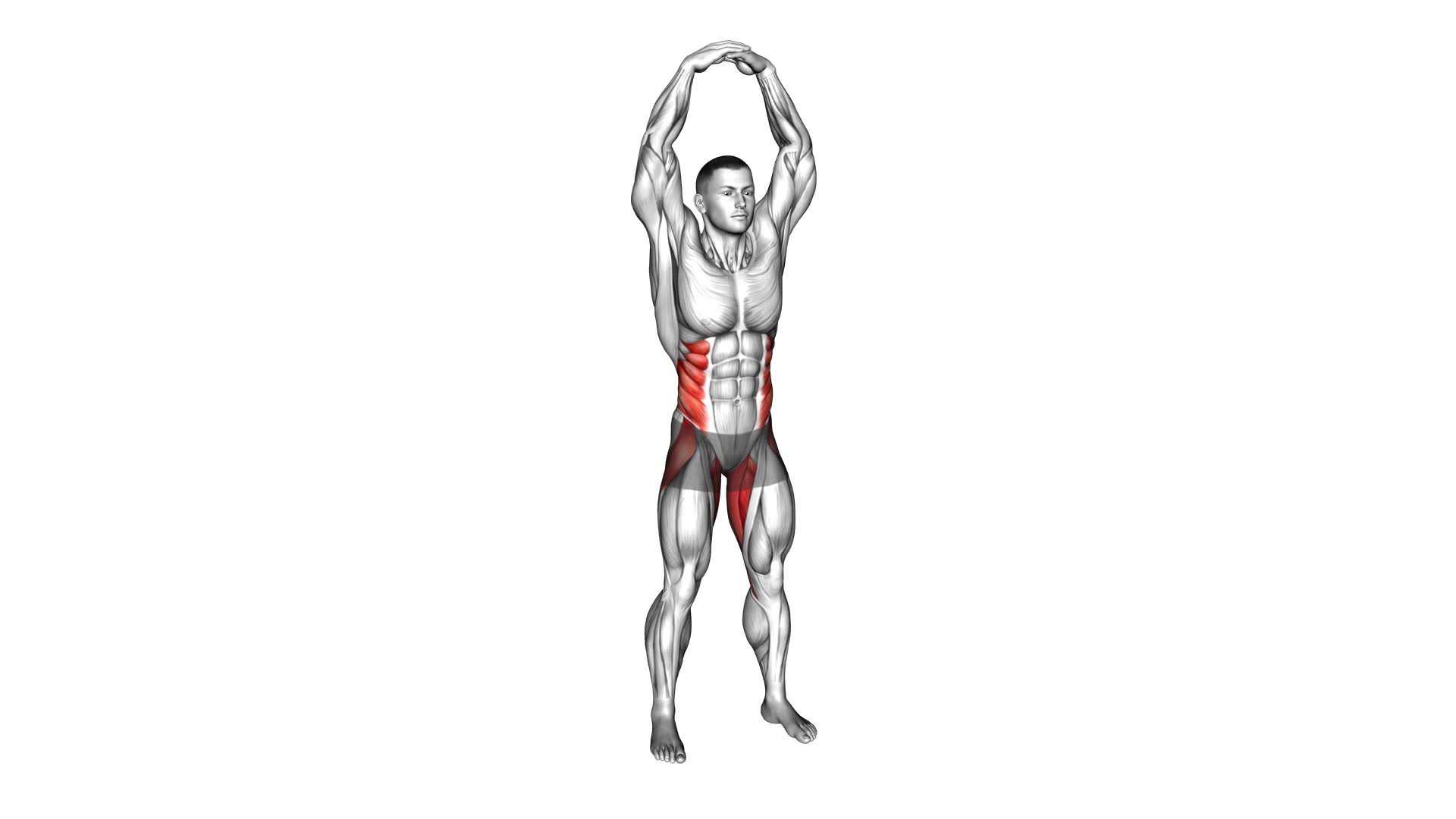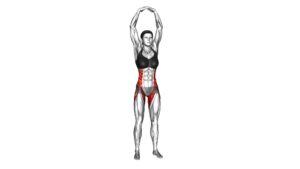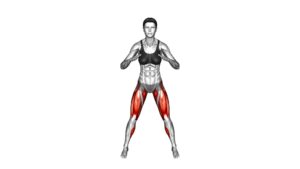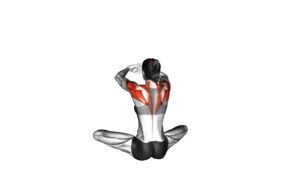Ballerina Foot Tap Adduction (male) – Video Exercise Guide & Tips

Get ready to improve your ballerina foot tap adduction with this video exercise guide! In just a few minutes, you'll learn the proper technique, common mistakes to avoid, and tips for boosting flexibility and strength.
Watch This Exercise Video
Whether you're a beginner or an advanced dancer, this guide has got you covered. So, grab your mat and get ready to enhance your dance skills with this informative and concise video tutorial.
Let's get those feet tapping!
Key Takeaways
- Dynamic stretches are important for warm-up and preparation for intense physical activity.
- The foot tap adduction exercise improves hip, knee, and ankle mobility and flexibility.
- It is important to avoid common mistakes such as forcefully slamming the foot down and rushing through the exercise.
- Beginners should focus on proper alignment and technique, while advanced dancers can add resistance or increase speed and intensity.
Proper Warm-Up Exercises
Start your warm-up routine by performing a series of dynamic stretches to prepare your body for the ballerina foot tap adduction exercise. Dynamic stretches, unlike static stretches, involve continuous movement and help increase blood flow, flexibility, and range of motion. They're essential for warming up the muscles and joints, reducing the risk of injury during intense physical activity.
When performing dynamic stretches, it's crucial to pay close attention to proper form. Maintaining proper form ensures that you're targeting the correct muscles and maximizing the effectiveness of the warm-up routine. It also helps prevent any unnecessary strain or stress on the body.
Some dynamic stretches that are beneficial for the ballerina foot tap adduction exercise include leg swings, hip circles, and ankle rotations. These exercises focus on loosening up the hip, knee, and ankle joints, improving their mobility and flexibility. By incorporating these dynamic stretches into your warm-up routine, you're preparing your body for the demands of the foot tap adduction exercise, allowing for optimal performance and reducing the risk of injury.
Now that you have properly warmed up your body with dynamic stretches, it's time to move on to the step-by-step breakdown of the foot tap adduction exercise.
Step-By-Step Breakdown of the Foot Tap Adduction
Continuing from the previous subtopic, begin by performing the foot tap adduction exercise with proper form and technique. This exercise specifically targets the muscles of the inner thigh, helping to improve your overall lower body strength and stability.
To perform the foot tap adduction exercise correctly, follow these steps:
- Start by standing with your feet shoulder-width apart.
- Lift your right foot off the ground and bring it slightly behind your left foot.
- Keeping your right leg straight, tap your right foot to the side, bringing it as close to your left foot as possible.
- Return your right foot to the starting position and repeat the movement for the desired number of repetitions.
- Switch sides and repeat the exercise with your left leg.
By incorporating the foot tap adduction exercise into your workout routine, you can experience several benefits. This exercise helps to strengthen and tone the muscles of the inner thigh, improving your balance and stability. Additionally, it can also help to enhance your overall lower body coordination and flexibility.
Remember to maintain proper form throughout the exercise and engage your core muscles for optimal results.
Common Mistakes to Avoid
To perform the foot tap adduction exercise correctly, you should be mindful of common mistakes to avoid. Understanding these mistakes will help ensure that you maximize the benefits of the foot tap adduction exercise.
One common mistake is using excessive force when tapping your foot. Remember, this exercise is about control and precision, so avoid forcefully slamming your foot down. Instead, focus on tapping your foot gently and smoothly. This will help engage the muscles in your leg and improve your overall technique.
Another mistake is neglecting proper posture and alignment. It's important to maintain a tall and straight posture throughout the exercise. Avoid slouching or leaning forward, as this can put unnecessary strain on your back and diminish the effectiveness of the exercise. Keeping your core engaged and your shoulders relaxed will also contribute to better form and a more efficient workout.
Lastly, rushing through the exercise is a common mistake to avoid. Take your time and perform each tap with intention and control. By doing so, you'll engage the targeted muscles more effectively and maximize the benefits of the foot tap adduction exercise.
Tips for Improving Flexibility and Strength
Improving flexibility and strength can be achieved by incorporating stretching and strengthening exercises into your routine. Here are three tips to help you increase your range of motion and prevent injuries:
- Gradual Progression: When working on your flexibility and strength, it's important to start slowly and gradually increase the intensity of your exercises. Pushing yourself too hard too soon can lead to muscle strains or other injuries. Begin with gentle stretches and exercises and gradually increase the duration and intensity over time. This will allow your body to adapt and improve without putting excessive stress on your muscles and joints.
- Balanced Training: To improve both flexibility and strength, it's crucial to include a balanced combination of stretching and strengthening exercises in your routine. Stretching exercises like static stretches or dynamic stretching can help increase your range of motion, while strengthening exercises like resistance training can build muscle strength and stability. By incorporating both types of exercises, you can enhance your overall performance and reduce the risk of imbalances or injuries.
- Proper Form and Technique: Paying attention to your form and technique is essential for improving flexibility and strength effectively and safely. Performing exercises with improper form can't only limit your progress but also increase the risk of injuries. Take the time to learn and understand the correct form for each exercise, and focus on maintaining proper alignment and posture throughout your training. If needed, consider working with a qualified trainer or instructor who can guide you and provide feedback on your technique.
Modifications for Beginners and Advanced Dancers
To modify the exercises for beginners and advanced dancers, it's important to tailor the movements to the individual's skill level and experience.
For beginners, it's crucial to start with proper alignment and technique before progressing to more complex variations. This allows beginners to build a solid foundation and reduce the risk of injuries. Beginners can also benefit from starting with smaller ranges of motion and gradually increasing as they become more comfortable. It's important for beginners to focus on developing strength and flexibility in the muscles used for foot tap adduction.
Advanced dancers, on the other hand, can modify the exercises by adding resistance or increasing the speed and intensity of the movements. This helps to challenge their strength and coordination, allowing them to further improve their technique. Advanced dancers can also explore variations of the foot tap adduction exercise, such as incorporating jumps or turns, to add complexity and artistry to their movements.
Regardless of the skill level, it's important to listen to your body and make modifications for any injuries or limitations. This may involve reducing the range of motion, using props for support, or seeking professional guidance.
Modifying the exercises for beginners and advanced dancers not only helps to prevent injuries, but also ensures that each individual is able to reap the benefits of foot tap adduction, such as increased strength, flexibility, and coordination.
Frequently Asked Questions
What Are the Benefits of Performing the Ballerina Foot Tap Adduction Exercise?
Performing the ballerina foot tap adduction exercise offers several benefits.
By engaging your inner thigh muscles, it helps to strengthen and tone your legs.
This exercise also improves your balance and stability, as it requires control and precision.
Additionally, the ballerina foot tap adduction exercise can enhance your coordination and flexibility.
To perform this exercise correctly, you need to maintain proper technique and alignment throughout the movement.
How Often Should the Ballerina Foot Tap Adduction Exercise Be Performed?
To determine how often to perform the ballerina foot tap adduction exercise, consider the frequency and timing that best suits your fitness goals. The ideal frequency may vary depending on factors such as your current fitness level and any existing injuries. Consult a qualified fitness professional to create a personalized exercise plan that includes the ballerina foot tap adduction exercise. They can specify the recommended frequency and timing for optimal results.
Are There Any Specific Precautions or Contraindications for Performing This Exercise?
When performing the Ballerina Foot Tap Adduction exercise, it's important to be aware of any precautions or contraindications.
Precautions refer to any specific conditions or circumstances that may require modifications or adjustments to the exercise.
Contraindications, on the other hand, are conditions that make it unsafe or inadvisable to perform the exercise altogether.
It's always recommended to consult with a healthcare professional or qualified trainer to determine if there are any specific precautions or contraindications for you before attempting this exercise.
Can the Ballerina Foot Tap Adduction Exercise Help With Improving Balance and Coordination?
The ballerina foot tap adduction exercise is effective for improving balance and coordination. It targets the muscles in your feet and legs that are crucial for maintaining stability and control during dance movements.
Compared to other balance and coordination exercises, this exercise specifically targets the muscles used in ballet and can help dancers enhance their technique.
Are There Any Variations or Progressions of the Exercise for More Advanced Dancers?
There are several variations and progressions of the ballerina foot tap adduction exercise for more advanced dancers. These variations can help to further challenge your balance and coordination skills.
You may try increasing the speed of the foot taps or incorporating more complex foot patterns. Another progression is to add resistance by using ankle weights or resistance bands.
These variations and progressions can help you continue to improve and advance in your dance training.
Conclusion
In conclusion, the foot tap adduction exercise is a beneficial movement for male ballerinas to improve their flexibility and strength.
By following the proper warm-up exercises and avoiding common mistakes, dancers can effectively perform this exercise.
Additionally, modifications are available for both beginners and advanced dancers to cater to their individual needs.
With regular practice and dedication, dancers can enhance their performance and achieve their goals in the field of ballet.

Author
Years ago, the spark of my life’s passion ignited in my mind the moment I stepped into the local gym for the first time. The inaugural bead of perspiration, the initial endeavor, the very first surge of endorphins, and a sense of pride that washed over me post-workout marked the beginning of my deep-seated interest in strength sports, fitness, and sports nutrition. This very curiosity blossomed rapidly into a profound fascination, propelling me to earn a Master’s degree in Physical Education from the Academy of Physical Education in Krakow, followed by a Sports Manager diploma from the Jagiellonian University. My journey of growth led me to gain more specialized qualifications, such as being a certified personal trainer with a focus on sports dietetics, a lifeguard, and an instructor for wellness and corrective gymnastics. Theoretical knowledge paired seamlessly with practical experience, reinforcing my belief that the transformation of individuals under my guidance was also a reflection of my personal growth. This belief holds true even today. Each day, I strive to push the boundaries and explore new realms. These realms gently elevate me to greater heights. The unique combination of passion for my field and the continuous quest for growth fuels my drive to break new ground.



